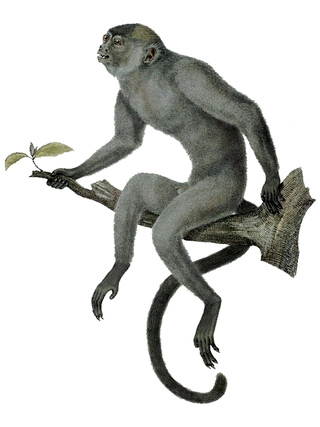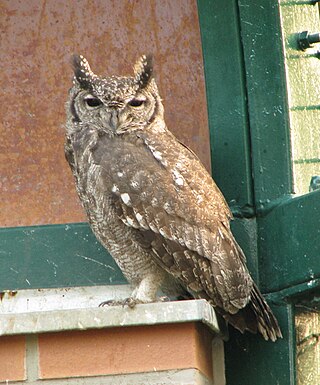Related Research Articles

The ashy black titi monkey is a species of titi monkey, a type of New World monkey, endemic to Brazil. It was originally described as Callithrix cinerascens in 1823.

Goupia is a neotropical genus of flowering plants and the sole genus included in the family Goupiaceae. There are three species, all found in tropical northern South America.

The ash-throated flycatcher is a passerine bird in the tyrant flycatcher family.

The brushland tinamou is a type of tinamou commonly found in high-altitude dry shrubland in subtropical and tropical regions of southern South America.

The grey antbird is a species of bird in the antbird family Thamnophilidae. It is found in Bolivia, Brazil, Colombia, Ecuador, French Guiana, Guyana, Peru, Suriname, and Venezuela. Its natural habitat is subtropical or tropical moist lowland forests.

The Sumatran treepie or Sunda treepie is a species of bird in the family Corvidae. It is endemic to the island of Sumatra in Indonesia. Its natural habitats are subtropical or tropical moist lowland forest and subtropical or tropical moist montane forest. The Bornean treepie is sometimes considered to be a subspecies of this bird.

The white-browed forest flycatcher is a species of bird in the family Muscicapidae.

The island monarch is a species of bird in the family Monarchidae. It is found from Sulawesi to the Solomon Islands. Its natural habitats are subtropical or tropical moist lowland forests and subtropical or tropical moist montane forests.

Nothoprocta is a genus of birds belonging to the tinamou family Tinamidae. They inhabit scrubland, grassland and open woodland in western South America, particularly in the Andes. They are poor fliers and spend most of their time on the ground. Their diet includes seeds and insects. They nest on the ground, laying large glossy eggs. The eggs are covered with feathers when a potential predator is nearby.

The western banded snake eagle is a grey-brown African raptor with a short tail and a large head. Juveniles have paler and browner upper parts than adults, with white-edged feathers. The eagle's head, neck and breast are dark-streaked. The underparts are white with pale brown streaks, mainly on belly and thighs. Subadults may be all dark grey-brown without any streak on underparts. The eyes, ears, and legs are yellow. They have crested chests.

The Bornean treepie is a passerine bird belonging to the treepies genus, Dendrocitta, of in the crow family, Corvidae. It is endemic to the island of Borneo. It is sometimes treated as a subspecies of the Sumatran treepie.

The greyish eagle-owl or vermiculated eagle-owl is a rather large owl of the northern part of sub-Saharan Africa. It was previously regarded as the northern subspecies of the spotted eagle-owl.

Dillwynia cinerascens, commonly known as grey parrot-pea, is a species of flowering plant in the family Fabaceae and is endemic to south-eastern Australia. It is an erect to low-lying shrub with linear or thread-like leaves and orange or yellow flowers.

Crossotini is a tribe of longhorn beetles of the subfamily Lamiinae. It was described by Thomson in 1864.

Megalofrea is a genus of longhorn beetles of the subfamily Lamiinae.

Megalofrea bioculata is a species of beetle in the family Cerambycidae. It was described by Fairmaire in 1889. It is known from Madagascar.
Megalofrea decorsei is a species of beetle in the family Cerambycidae. It was described by Fairmaire in 1901. It is known from Madagascar.

Kyphosus cinerascens is a species of marine ray-finned fish. It is a sea chub from the family Kyphosidae. Kyphosus Cinerascens has 11 dorsal fins and 12 anal fins. Kyphosus cinerascens are widely distributed in the Indo-Pacific region. The Kyphosus cinerascens has a strict diet on phaeophytes, chlorophytes, and rhodophytes, making them herbivores.
Orbivestus cinerascens is a plant in the family Asteraceae.
Myosotis × cinerascens is a hybrid species of flowering plant in the family Boraginaceae, endemic to the South Island of New Zealand. Donald Petrie described M. cinerascens in 1891, and it was later deemed to be a hybrid in 2021. Plants of this forget-me-not are perennial rosettes which form tufts or clumps, with ebracteate, erect inflorescences, and white corollas with partly exserted stamens.
References
- ↑ BioLib.cz - Megalofrea cinerascens. Retrieved on 8 September 2014.